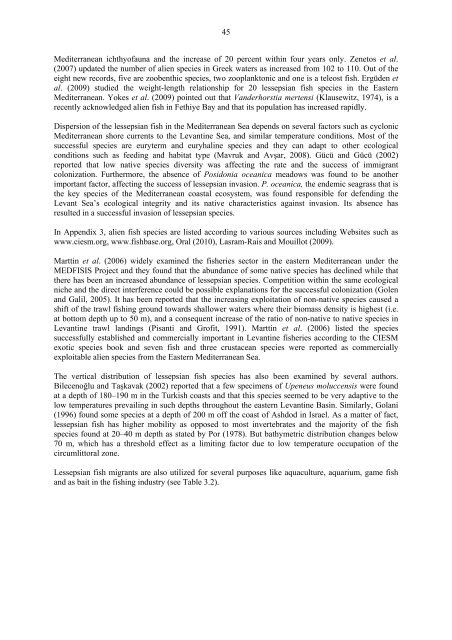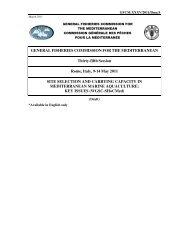Status of alien species in the Mediterranean and Black Sea
Status of alien species in the Mediterranean and Black Sea
Status of alien species in the Mediterranean and Black Sea
You also want an ePaper? Increase the reach of your titles
YUMPU automatically turns print PDFs into web optimized ePapers that Google loves.
45<br />
<strong>Mediterranean</strong> ichthy<strong>of</strong>auna <strong>and</strong> <strong>the</strong> <strong>in</strong>crease <strong>of</strong> 20 percent with<strong>in</strong> four years only. Zenetos et al.<br />
(2007) updated <strong>the</strong> number <strong>of</strong> <strong>alien</strong> <strong>species</strong> <strong>in</strong> Greek waters as <strong>in</strong>creased from 102 to 110. Out <strong>of</strong> <strong>the</strong><br />
eight new records, five are zoobenthic <strong>species</strong>, two zooplanktonic <strong>and</strong> one is a teleost fish. Ergüden et<br />
al. (2009) studied <strong>the</strong> weight-length relationship for 20 lessepsian fish <strong>species</strong> <strong>in</strong> <strong>the</strong> Eastern<br />
<strong>Mediterranean</strong>. Yokes et al. (2009) po<strong>in</strong>ted out that V<strong>and</strong>erhorstia mertensi (Klausewitz, 1974), is a<br />
recently acknowledged <strong>alien</strong> fish <strong>in</strong> Fethiye Bay <strong>and</strong> that its population has <strong>in</strong>creased rapidly.<br />
Dispersion <strong>of</strong> <strong>the</strong> lessepsian fish <strong>in</strong> <strong>the</strong> <strong>Mediterranean</strong> <strong>Sea</strong> depends on several factors such as cyclonic<br />
<strong>Mediterranean</strong> shore currents to <strong>the</strong> Levant<strong>in</strong>e <strong>Sea</strong>, <strong>and</strong> similar temperature conditions. Most <strong>of</strong> <strong>the</strong><br />
successful <strong>species</strong> are euryterm <strong>and</strong> euryhal<strong>in</strong>e <strong>species</strong> <strong>and</strong> <strong>the</strong>y can adapt to o<strong>the</strong>r ecological<br />
conditions such as feed<strong>in</strong>g <strong>and</strong> habitat type (Mavruk <strong>and</strong> Avşar, 2008). Gücü <strong>and</strong> Gücü (2002)<br />
reported that low native <strong>species</strong> diversity was affect<strong>in</strong>g <strong>the</strong> rate <strong>and</strong> <strong>the</strong> success <strong>of</strong> immigrant<br />
colonization. Fur<strong>the</strong>rmore, <strong>the</strong> absence <strong>of</strong> Posidonia oceanica meadows was found to be ano<strong>the</strong>r<br />
important factor, affect<strong>in</strong>g <strong>the</strong> success <strong>of</strong> lessepsian <strong>in</strong>vasion. P. oceanica, <strong>the</strong> endemic seagrass that is<br />
<strong>the</strong> key <strong>species</strong> <strong>of</strong> <strong>the</strong> <strong>Mediterranean</strong> coastal ecosystem, was found responsible for defend<strong>in</strong>g <strong>the</strong><br />
Levant <strong>Sea</strong>’s ecological <strong>in</strong>tegrity <strong>and</strong> its native characteristics aga<strong>in</strong>st <strong>in</strong>vasion. Its absence has<br />
resulted <strong>in</strong> a successful <strong>in</strong>vasion <strong>of</strong> lessepsian <strong>species</strong>.<br />
In Appendix 3, <strong>alien</strong> fish <strong>species</strong> are listed accord<strong>in</strong>g to various sources <strong>in</strong>clud<strong>in</strong>g Websites such as<br />
www.ciesm.org, www.fishbase.org, Oral (2010), Lasram-Rais <strong>and</strong> Mouillot (2009).<br />
Martt<strong>in</strong> et al. (2006) widely exam<strong>in</strong>ed <strong>the</strong> fisheries sector <strong>in</strong> <strong>the</strong> eastern <strong>Mediterranean</strong> under <strong>the</strong><br />
MEDFISIS Project <strong>and</strong> <strong>the</strong>y found that <strong>the</strong> abundance <strong>of</strong> some native <strong>species</strong> has decl<strong>in</strong>ed while that<br />
<strong>the</strong>re has been an <strong>in</strong>creased abundance <strong>of</strong> lessepsian <strong>species</strong>. Competition with<strong>in</strong> <strong>the</strong> same ecological<br />
niche <strong>and</strong> <strong>the</strong> direct <strong>in</strong>terference could be possible explanations for <strong>the</strong> successful colonization (Golen<br />
<strong>and</strong> Galil, 2005). It has been reported that <strong>the</strong> <strong>in</strong>creas<strong>in</strong>g exploitation <strong>of</strong> non-native <strong>species</strong> caused a<br />
shift <strong>of</strong> <strong>the</strong> trawl fish<strong>in</strong>g ground towards shallower waters where <strong>the</strong>ir biomass density is highest (i.e.<br />
at bottom depth up to 50 m), <strong>and</strong> a consequent <strong>in</strong>crease <strong>of</strong> <strong>the</strong> ratio <strong>of</strong> non-native to native <strong>species</strong> <strong>in</strong><br />
Levant<strong>in</strong>e trawl l<strong>and</strong><strong>in</strong>gs (Pisanti <strong>and</strong> Gr<strong>of</strong>it, 1991). Martt<strong>in</strong> et al. (2006) listed <strong>the</strong> <strong>species</strong><br />
successfully established <strong>and</strong> commercially important <strong>in</strong> Levant<strong>in</strong>e fisheries accord<strong>in</strong>g to <strong>the</strong> CIESM<br />
exotic <strong>species</strong> book <strong>and</strong> seven fish <strong>and</strong> three crustacean <strong>species</strong> were reported as commercially<br />
exploitable <strong>alien</strong> <strong>species</strong> from <strong>the</strong> Eastern <strong>Mediterranean</strong> <strong>Sea</strong>.<br />
The vertical distribution <strong>of</strong> lessepsian fish <strong>species</strong> has also been exam<strong>in</strong>ed by several authors.<br />
Bilecenoğlu <strong>and</strong> Taşkavak (2002) reported that a few specimens <strong>of</strong> Upeneus moluccensis were found<br />
at a depth <strong>of</strong> 180–190 m <strong>in</strong> <strong>the</strong> Turkish coasts <strong>and</strong> that this <strong>species</strong> seemed to be very adaptive to <strong>the</strong><br />
low temperatures prevail<strong>in</strong>g <strong>in</strong> such depths throughout <strong>the</strong> eastern Levant<strong>in</strong>e Bas<strong>in</strong>. Similarly, Golani<br />
(1996) found some <strong>species</strong> at a depth <strong>of</strong> 200 m <strong>of</strong>f <strong>the</strong> coast <strong>of</strong> Ashdod <strong>in</strong> Israel. As a matter <strong>of</strong> fact,<br />
lessepsian fish has higher mobility as opposed to most <strong>in</strong>vertebrates <strong>and</strong> <strong>the</strong> majority <strong>of</strong> <strong>the</strong> fish<br />
<strong>species</strong> found at 20–40 m depth as stated by Por (1978). But bathymetric distribution changes below<br />
70 m, which has a threshold effect as a limit<strong>in</strong>g factor due to low temperature occupation <strong>of</strong> <strong>the</strong><br />
circumlittoral zone.<br />
Lessepsian fish migrants are also utilized for several purposes like aquaculture, aquarium, game fish<br />
<strong>and</strong> as bait <strong>in</strong> <strong>the</strong> fish<strong>in</strong>g <strong>in</strong>dustry (see Table 3.2).
















